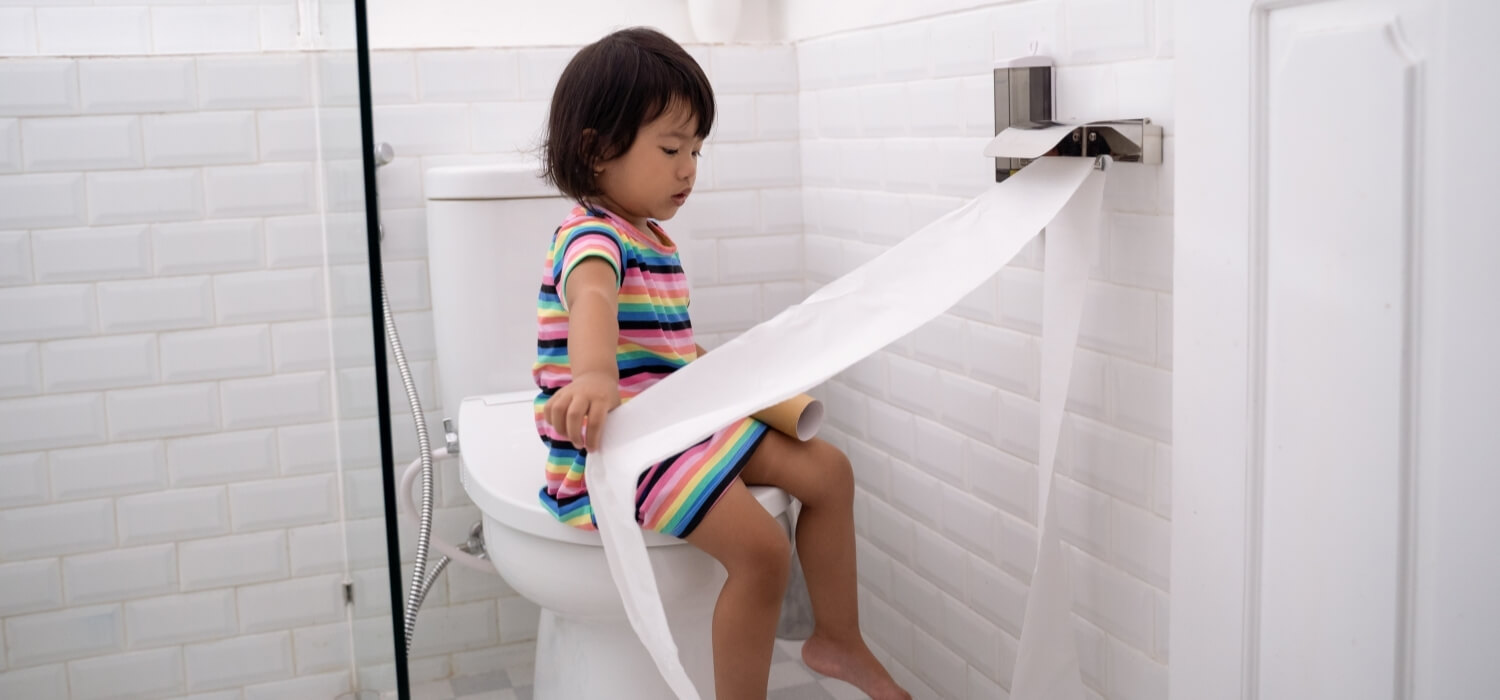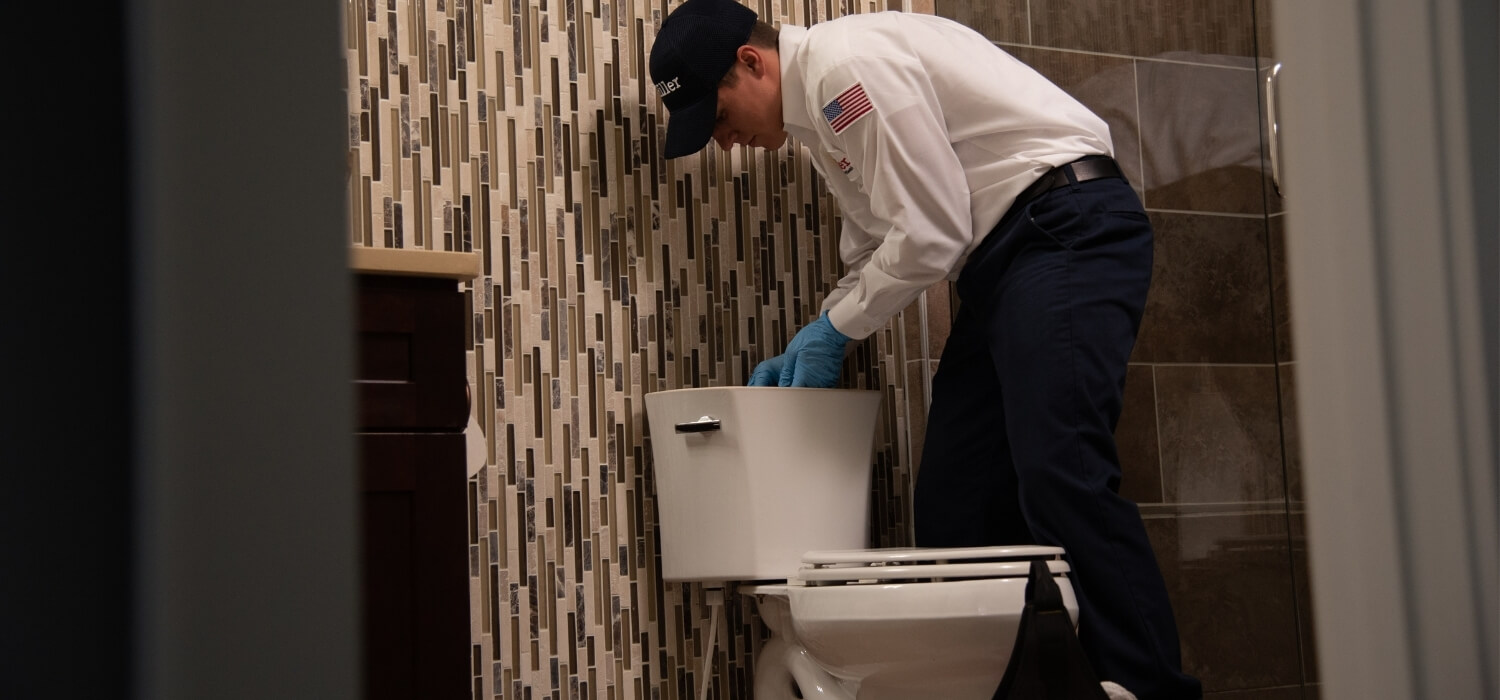This Is What to Do When Your Toilet Is Overflowing
Enjoy reading the latest DIY articles and saving money?
Receive our latest helpful hints, tricks and savings, directly to your inbox.
Posted January 8, 2021
It’s the middle of the night and you’re awoken by a rumbling in your gut. You stumble to the toilet, do your business, and wash your hands. But as you turn off the sink and head back to bed, you hear a horrifying sound… The sound of water leaking onto the floor as your toilet is overflowing.
Your adrenaline kicks in as you flip the lights back on and race for the plunger. You try to maneuver yourself into a position to unclog the toilet while avoiding the dripping of dirty water around your feet. The water finally drains, but now you’re stuck with a wet floor, a pounding heart, and dashed hopes for getting back to sleep.
Sound familiar?
This nightmare scenario happens to almost all of us at one point or another. For some, it’s more frequent than others, whether due to bathroom habits, poor toilets, or plumbing issues. While a flooded toilet might be embarrassing, it’s not uncommon. That’s why it’s important for everyone to know what to do if your toilet overflows. Prepare yourself for the deluge with the tips below!
Why Do Toilets Overflow?

Toilets are elegant, yet simple machines. When working properly, they can handle the most stubborn bits of waste with ease.
A toilet works with a few basic components: a bowl, a reservoir tank with a flapper and a float, a siphon jet, and a trapway or p-trap that drains water out.
When you press the handle, it lifts the flapper in the tank. This sends water rushing from the tank into the bowl along the rim and through the siphon jet.
The force of the water through the siphon jet pushes the contents of the bowl into the trapway. Gravity then creates a siphon effect, sucking the water from the bowl down the drain.
Meanwhile, in the tank, the float drops with the water level. This triggers a flow of water into the tank. Once the float reaches its designated height, the water shuts off, ready for the next flush.
Unfortunately, a few things can get in the way of that process working properly.
Obstructions in the Bowl
The most common cause of an overflowing toilet is some sort of obstruction in the bowl. When the siphon jet pushes the water into the trapway, something in the bowl gets lodged in the p-trap, creating a clog.
This is commonly human waste or toilet paper, but there have been several stranger clogs.
If the trapway becomes clogged, the contents of the bowl have nowhere to go. Unfortunately, there’s no way to stop the water in the tank from rushing into the bowl, so it starts overflowing.
Luckily, most clogs in the bowl can be handled with a plunger.
Too Much Water in the Reservoir Tank
The reservoir tank is designed to hold as much water as the bowl needs to fill for the next flush. However, if your float is set too high, it could fill the tank with more water than recommended for proper operation.
This overfills the bowl when you flush. And if your bowl is already too full, it can increase the chances that the water will flow over the rim.
Check your float and see where it’s set. Most tanks will have a fill line marked on the inside. If the water level is above this line, lower the float.
Clogs Beyond the Trapway
Even if your toilet is working perfectly, you might still find yourself dealing with overflows on occasion.
This often happens when there is a clog further down your plumbing system. Something might clear your p-trap, only to get caught in a pipe somewhere between the toilet and the sewer.
If debris has been building up for a while, it could eventually lead to a clog that causes problems when a large influx of water rushes through the pipe—like a toilet flush.
This might also be a result of tree roots growing into your sewage line, which is especially common in older city homes.
If this happens, your best bet is to immediately call an emergency plumber.
A Blocked Vent
Before the flush, the p-trap is filled with water that prevents the sewer gasses from entering the home. When water rushes in, that air needs to go somewhere to make room. The drain that your toilet is tied into has what is called a soil stack vent.
This vent is usually routed out of your roof and allows air in your plumbing to escape.
However, if this vent becomes blocked, it can cause pressure to build up in your pipes. When you flush your toilet, the influx of water greatly increases this pressure, and it will try to escape wherever it can.
Usually, this means back out of the toilet.
If you suspect that your soil stack vent might be blocked, this is another job for a plumber.
A Full Septic Tank
If your house is outfitted with a septic tank, you can experience clogs when it becomes full.
Instead of a city sewer line, all sewage from the house runs into the septic tank. Solids settle on the bottom of the tank while water flows out to a septic field.
But if it becomes too filled with solids, then incoming sewage has nowhere to go.
When you flush your toilet, the water can’t exit your house, leaving it to pool in your drains.
Septic tanks need to be emptied periodically. This should only be done by a specialist.
What To Do When Your Toilet Overflows

Knowing why a toilet overflows is one thing. Knowing what to do when the water is rising is another.
If you find yourself staring down the barrel of a toilet about to overflow, here’s what you need to do.
Be Proactive
As the old saying goes, “An ounce of prevention is worth a pound of cure.” That’s especially true for overflowing toilets.
Stopping a toilet before it overflows is a much better option than dealing with the aftermath.
Often, a toilet overflows because you flush it without realizing that it clogged on the previous flush. This is when the water flows over the rim.
Make sure that each flush is successful. Make sure the water drains the way it’s supposed to before leaving the toilet.
If you have a particularly productive bathroom session, don’t try to flush all of the waste and toilet paper all at once. This increases your chances of creating a clog when you’re finished.
Instead, flush as you go to keep obstructions from happening. Or, at the very least, flush between going and wiping. Toilet paper may be designed to flush easily, but if you use a particularly thick variety or a large amount, it can create a clog in a hurry.
Act Fast
If you do notice that your toilet is clogged, it’s time to act fast.
If you panic and freeze up, it can lead to more water dripping onto the floor, making the problem worse.
Grab a couple of towels to catch water around the base of the toilet and get to work.
Turn Off the Water
The first thing to do is to stop the water in the tank from filling the bowl anymore
Take off the lid of the tank and press the flapper down to prevent any more water from escaping. This water is clean, so it’s fine to use your hands. However, if you’d rather not stick your hand in toilet water, you can use the handle end of the plunger.
After the flapper is in place, no more water should leave the bowl. However, if you want to be extra careful, you can turn off the water going into the tank.
For most toilets, you can find a small waterline with a shut-off valve behind the toilet near the floor. Turn this to the right to stop the flow of water to the tank.
Be careful not to overtighten this valve, as the waterline itself can be delicate. Turning it too much can damage the seals that keep this line from leaking.
Grab A Plunger
Once you’ve stopped the water level from rising any higher, it’s time to deal with the clog itself.
The best tool for this is a good old fashioned plunger. A plunger creates additional pressure in the p-trap at the source of the clog while blocking any more liquid from returning into the bowl. This can force most clogs through the pipes.
Fit the plunger snugly around the opening to the trapway and pump down a few times. Be careful as you maneuver the plunger: careless or frantic motions could cause more water to spill.
After a few pumps, the blockage should be released into the drain, allowing the water in the bowl to flow freely.
If the toilet does not drain after plunging it, this should tell you that there is a more serious problem causing the clog. Call a plumber before trying to use your toilet again.
Don’t Let Spilled Water Sit
If you didn’t get to your clog before the toilet started overflowing, then you will have to deal with the water that’s spilled onto the floor.
The last thing you want to do after unclogging a toilet is dealing with more toilet water. But leaving this to dry on its own can cause major problems.
This water most likely contains urine and fecal matter. Needless to say, you don’t want that hanging around on your bathroom floors.
Besides the gross factor of the excess water, this water can also seep into wood floors or between the cracks of linoleum tiles, absorbing into the material and contributing to rot.
Use disposable paper towels or a junky rag to soak up the water. You can use a nicer towel if you want, but keep bleach on hand to wash it.
Once the water is soaked up, use a surface cleaner to kill any bacteria that might remain.
Other Common Toilet Issues

Overflowing toilets are a nuisance, but they’re hardly the only problem that a toilet might face.
Here are a few other issues that you might run into—and how you can fix them.
Tank Keeps Running
Water runs into the toilet when the float drops below the fill line. If it runs when you haven’t flushed, this usually means your flapper is leaking.
Make sure the chain from the handle to the handle isn’t too taut to keep the flapper resting flush. If that’s not the case, replace the flapper.
Bowl Fills Slowly
It shouldn’t take long to fill your tank after a flush. If it does, it might be a sign that there’s a clog in the waterline into the tank.
Check the opening for buildup from minerals in hard water. If that looks clean, make sure the valve is all the way open.
Excess Water Around Base
If you notice water around the base of your toilet—or if the floor is damp or soft to the touch—that’s a major problem. You might also notice water damage on the ceiling in a room below an upstairs toilet.
Toilets are fitted onto the ground drain using a wax seal. If this seal wasn’t installed properly, or if it’s degraded, it can cause a leak. You will need a new seal to fix this. This can be done yourself, but it’s highly recommended to call a plumber.
This might also be a sign of a leak in your waterline. Check that for issues before replacing the wax seal.
An Overflowing Toilet Isn’t the End of the World

If your toilet overflows, it can cause worry and embarrassment, but it doesn’t need to cause panic.
By following these steps, you can show your stubborn toilet who’s boss and go back to sleep without worry.
However, if your problem doesn’t go away that easily—or if you have a problem with your HVAC or electric—give us a call.
 Daily Promotion
Daily Promotion
$500 Off Tankless Water Heater
Upgrade your comfort and give back this season.
Get Promotion